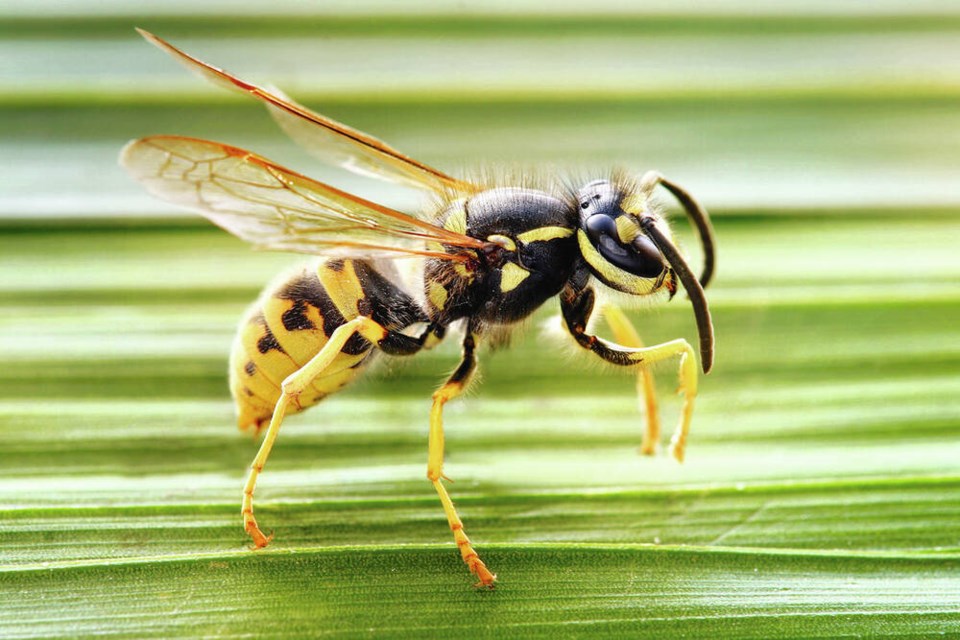I got caught doing the bee-slapping dance again.
It happened after a wasp flew inside my bike helmet as I rode down the Lochside Trail from Sidney last Sunday. At first I hoped it was just a hit-and-run job, in one slit and out the other, and that I could keep pedalling.
But then I felt the wasp’s little legs stirring against my scalp as he recovered from the blow. He might have been stunned but he was still in the fight, Rocky Balbeea willing himself off the canvas, ready to go one more round with Apollo Creed. Float like a butterfly, sting like a…
So I did what any rationale human would do: threw my bicycle into the blackberry bushes, tore off my helmet and began running in tight little circles while flailing at my head.
That’s when a young woman rounded the corner.
I’m never sure what to do in such situations, the ones when you find yourself isolated with a stranger — in an elevator, say — and don’t want her to feel ill at ease.
Should you act as though she’s invisible? Make eye contact? Smile winningly? No, not the latter. I’m probably past the stage of appearing dangerous, though a solid argument could be made for creepy.
Moot point, in this case. There was no escaping the woman’s first impression, the one that became as cemented as Jimmy Hoffa the moment she found her path barred by a crazed man frantically dancing and whacking himself in the noggin.
I could see her fingers reach for her pepper spray, then the mental head slap (there’s irony!) as she realized she had left it at home.
Fortunately, I was able to regain my senses. “I’m Les Leyne! I’m Les Leyne!” I called after her as she sped away.
Longtime readers might recall that this was not my first such incident. Many years ago, I had another in-helmet encounter (and bee-slapping dance) as I rode to work along the Galloping Goose, though on that occasion I was actually stung.
The sting hurt, but that wasn’t my main concern. When was the last time I had been stung, I wondered. What if I were allergic?
What if I went into anaphylactic shock, lurched into the path of a transport truck and was squished like a bug (more irony!), leaving the world, or at least my insurance agent, to wonder why I would do such a thing. This thought choked me up — or was it the anaphylaxis?
Determined to outrace the toxin, I rode furiously to the office I shared with Jody Paterson. “My tongue is swollen and my throat is constricted,” I told her as I staggered in. “I’m probably dying.”
“You’re not dying,” she said. “You’re thirsty.”
Which brings us to the point of today’s column: the wasps are bad this year.
Actually, we say this each August. Wasps are like the snow that never falls on Victoria, except for every single winter. They show up at the end of summer just like clockwork (or the in-laws) and we moan about how unexpectedly terrible they are. (Basically, wasps are like the Leafs during the playoffs.)
What we don’t complain about is other flying, biting insects, because there aren’t any. This is one of Victoria’s under-rated selling points: Thanks to the offshore breeze, we don’t have the clouds of mosquitoes, no-see-ums and blackflies that you find in the parts of ÎÚÑ»´«Ã½ that God doesn’t love as much.
Except even that is troubling. These days, there aren’t as many flying insects even in areas where you would expect them. When was the last time you had to peer through a truly bug-spattered windshield?
The number of flying insects has fallen dramatically in many places. A British researcher labelled the two-decade decline in the U.K. “terrifying.”
Scientists trapping airborne bugs in German nature preserves recorded a 75 per cent drop over a quarter century (maybe they shouldn’t have trapped them, then).
The Nature Conservancy of ÎÚÑ»´«Ã½ is abuzz about the loss of pollinators, saying that invasive plants, urban sprawl and the overuse of pesticides have conspired against the mason bees, bumblebees, butterflies, moths, flower beetles and other creatures that we rely on for food to grow.
Vancouver Island honey producers worry about habitat disappearing as communities grow.
So, yes, the wasps are bad this year — but not as bad as the loss of the flying insects we don’t see at all.



